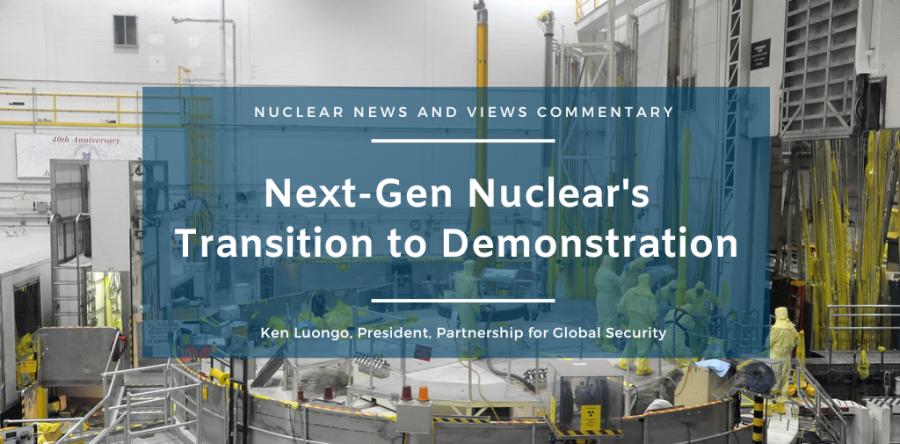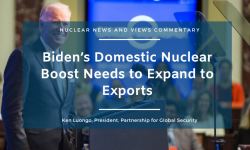Nuclear power is no longer asking for a seat at the clean energy technology table. It has been given a chair.
But the future zero-carbon contribution of nuclear energy rests increasingly on the deployment of small and modular reactors that are in many cases quite different from the existing global fleet of large reactors.
Those next-generation reactors have been aggressively rooted-on by a bipartisan mix of supporters in the U.S. But the transition is now underway from cheerleading the relevance of new nuclear to making it work at scale.
There are a few examples of the beginning of this evolution.
The U.S. Nuclear Regulatory Commission is in the cross hairs of both the Congress and some prominent nuclear-supporting NGO’s. The reason is the inability of the regulatory agency to satisfy demands for more efficient licensing of next-gen reactor technologies. The approval of these designs is critical for the global clean energy objectives of the Biden administration as well as its support for a U.S. nuclear export revival.
But the issue extends beyond the regulations and has put a spotlight on choices and tradeoffs. A prime example is NRC commissioner, Jeff Baran. He has been proposed for reappointment by the Biden administration, but that has caused a schism among environmental organizations that believe that nuclear power is an essential part of the climate solution.
The Breakthrough Institute asserts that Baran is a “defender of a regulatory system that has basically presided over the long-term decline of the nuclear sector in the U.S.” BTI considers nuclear energy to be essential to the achievement of climate targets and its position reflects a wider frustration among other pro-nuclear groups with what they see as the NRC’s plodding approach to next-gen reactor licensing.
However, another progressive pro-nuclear energy organization, the Good Energy Collective, supports Baran. It believes that his record is being distorted and that his approach on the commission is consistent with pushing the nuclear industry to put “its best foot forward.” It also notes his support for the participation of marginalized communities in nuclear decision making.
With Congress out of session for the July 4th recess, Baran’s term expired. It is still on the calendar for full Senate consideration but action on it is uncertain as is the outcome.
It is unusual for pro-nuclear environmental organizations to take opposite tacks on a civil nuclear issue. They have a common purpose in supporting nuclear power as part of the suite of clean energy technologies. But this is an example of the cross pressures that are created by success on policy and disagreements on implementation. More conflicts of this kind are likely to flare as the next-gen nuclear enterprise advances.
A cursory look at the IRA, the largest U.S. investment in clean energy, tells you why. The IRA was applauded by all clean energy allies. But building out that clean new capacity will require a significant expansion of America’s energy grid. That has led to legislation to streamline the permitting process for transmission projects. That acceleration has not been embraced by some environmental organizations, creating conflict between former allies.
Another indication of the pressure on new reactors to perform is the spinoff of reactor development organizations into public companies.
OKLO, an advanced reactor company that has been backed by OpenAI CEO, Sam Altman, is now being positioned to go public through a merger with a special purpose acquisition company also controlled by Altman. The company is valued at $850 million, and the public offering aims to raise $500 million for OKLO’s Aurora reactor. OKLO also is involved in a spent fuel separation project called CURIE. Spent fuel separation is a very controversial issue in U.S. national security and energy policy.
Other reactors being backed by billionaires, such as Bill Gates’ Terrapower, have not yet been directly exposed to financial market forces. However, the company did announce it raised $830 million in 2022 in private contributions.
The small reactor company with the most experience as a publicly traded company is NuScale. Its major investor to that point was Fluor Corporation.
Nuscale has an agreement with a consortium of western U.S. utility companies to purchase power from multiple reactor modules the company plans to build at INL. It also is receiving considerable U.S. government support for projects at home and abroad.
However, even with that substantial backing and a conventional reactor dsesign, NuScale’s stock price has been roughly halved over the last year. This raises questions about the financial market’s appetite for new nuclear concepts and potential controversies.
Another feature of the transition of small reactors to reality is the intensified engagement between reactor developers and major industries. Dow Inc. recently agreed to partner with X-Energy on the construction of several Xe-100 high-temperature gas reactors to power its Seadrift industrial site in Texas. This 4,700-acre site manufactures 4 million pounds of material per year for multiple products. The partnership would substantially reduce Dow’s carbon footprint, a benefit for all. The industrial application of next-gen reactors is an area of intense interest.
The skepticism about the role of nuclear energy in addressing climate change has largely dissipated. The U.S. government is now devoting billions of dollars to next-gen reactor development and demonstrations. This serves its climate objectives, the need to out-compete Russia and China for new international civil nuclear markets, and its incipient industrial policy.
The scale of this investment has been applauded by many. But the cheerleading period has ended, and the demonstration phase has begun. It is now time to deliver.
Ken Luongo, President, Partnership for Global Security




